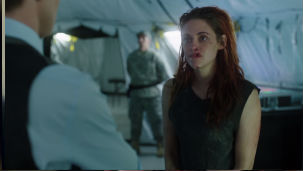There is an old adage: “a carpenter is only as good as his tools”. If anyone knows the truth of that saying, it is you. Sometimes you get precision-tooled equipment: pristine and flawless, stainless steel and factory fresh. Other times you have to make do with a single, rusty, duct taped POS hammer someone scrounged from Grandpa’s garage. Unfortunately the latter circumstance was the case with American Ultra.
Jesse Eisenberg is a lot of things. What he is not is a convincing simulacrum of Matt Damon. And that is what American Ultra required—inasmuch as it is a direct homage to, or pastiche of, the Bourne franchise. There once was a time when you could manage to work around an action star that was less than physically capable. Roger Moore made a career out of it. These days though, audiences are too film literate to let you get away with long shots, cutaways and POV trickery. For the most part they want to see the star get dirty.
If this was different kind of film, if it was less grounded in ‘reality’, if there was more CGI and it was a little more elevated —like Scott Pilgrim, for instance—it may have worked. But American Ultra is not that. It is thematically and structurally a direct heir to Doug Liman’s Bourne Identity, the first film in the Bourne Trilogy (the pissant little town Eisenberg’s character, Mike Howell, is trapped in is called Liman, in case there was any doubt). And that means no super powers and no obvious CGI. It requires a lead that can get up close and personal.
Eisenberg, who plays a sleeper CIA operative unaware of his past, is just not up to the task. There is a reason the people that are usually the leads in these kinds of films are who they are. Daniel Craig, Gina Carano, Matt Damon, anyone in the Raid films, are all cut from the same cloth. Even someone as diminutive as Chloe Moretz (Kick Ass’ Hitgirl) was convincing because she is physically capable. Ultimately, the kind of veracity a film like needs to ground it never emerges because Eisenberg is unpersuasive as an awakened CIA killbot.
As far as the rest of the cast goes, it is a mixed bag. Kristin Stewart does what she can as Eisenberg’s CIA handler/girlfriend but her character is underwritten and fuzzy in her motivations. Topher Grace seems to have gotten a different script than the rest of the cast, as his evil CIA bureaucrat is less Chris Cooper/Brian Cox and much more a cartoonish parody. Bill Pullman is perfect in his brief appearances, mostly because he is almost catatonic in his reserve—something this film could have used a lot more of.
Stewart is fine in her scenes and the staging and camera work isn’t bad, but it becomes obvious that Eisenberg can’t do the kind of close in work necessary to give the film the kind of intimate physicality it requires. Too many times when some complex interaction occurs, the camera pulls away or sits over Eisenberg’s shoulder—tricks that are used to insert stunt doubles. One of the effective conceits of the Bourne franchise and the new James Bond films is whenever possible, Craig and Damon are central to the action. You believe these actors can do what we are being asked to believe they can do, which makes a significant difference in the level of audience engagement and heightens the stakes enormously.
The best example I can think of is the first set piece in The Bourne Identity when Damon disarms two Swiss policemen and then renders them unconscious. The sequence is a wide shot, well lit, with some cuts, and it is clearly Damon himself who is engaging in the sequence. The mirror of that scene occurs towards the end of the first act of American Ultra, when a two-man team is sent to eliminate Eisenberg’s character. This sequence is poorly lit, choppily edited and it is not at all clear who is doing what to whom. Most importantly it does not establish Eisenberg as someone who is convincingly dangerous, and if we don’t believe that, then the movie’s central premise is fatally undermined.
It must have been a bit frustrating when you realized your toolkit was so limited, that you would have to make do instead of building something great. You’ve done good work elsewhere (Mission Impossible: Ghost Protocol) so I tend to think this was less the craftsman and more the tools. Maybe next time you will have what you need to build something truly superior.
Sincerely,

Tim







